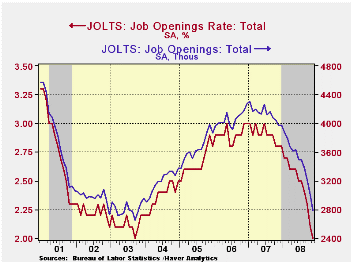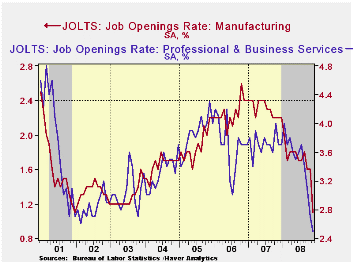 Global| Jan 13 2009
Global| Jan 13 2009JOLTS: U.S. Job Openings Lowest Since 2003
by:Tom Moeller
|in:Economy in Brief
Summary
The Bureau of Labor Statistics indicated in its November Job Openings & Labor Turnover Survey (JOLTS) report that the number of job openings fell 6.9% from October and by nearly one third from November 2007. The latest level was the [...]

The Bureau of Labor Statistics indicated in its November Job Openings & Labor Turnover Survey (JOLTS) report that the number of job openings fell 6.9% from October and by nearly one third from November 2007. The latest level was the lowest since October 2003. Since their peak in January of 2007 the number of job openings have fallen 35.2%.
The job openings rate also fell. The August rate was down to 2.3% versus an upwardly revised 2.5% in July. The latest figures are down from near 3% one year ago. The job openings rate is the number of job openings on the last business day of the month as a percent of total employment plus job openings.
The actual number of job openings in the construction and manufacturing sectors halved versus November of 2007. Professional & business services job openings fell by one third year-to-year while openings in the education & health sectors also were weak and they fell 17.0%. Openings in retail trade rose 11.9% y/y.
By region, openings in the South were off by one third while they fell by one quarter in the Midwest. In the West openings fell 30.7% and in the Northeast they were down 19.6%.
The hires rate fell to 2.6% which was the lowest in the series' short eight year history.The hires rate is the number of hires during the month divided by employment.The actual number of hires fell by nearly one quarter year-to-year and no sector showed any strength. Hires in the construction sector were off by nearly one third. In the factory sector hires fell 38.8% y/y and in the professional & business services sector they fell 20.3%. In the leisure and hospitality sector hires fell 31.6% y/y while hires in the educational & health sector fell 16.9%.
The job separations rate rose just slightly to 3.6% but remained down versus last year. Separations include quits, layoffs, discharges, and other separations as well as retirements. The level of job separations fell 3.5% y/y.
The JOLTS survey dates only to December 2000 but has since followed the movement in nonfarm payrolls, though the actual correlation between the two series is low.
A description of the Jolts survey and the latest release from the U.S. Department of Labor is available here and the figures are available in Haver's USECON database.
| JOLTS (Job Openings & Labor Turnover Survey) | November | October | November '07 | 2007 | 2006 | 2005 |
|---|---|---|---|---|---|---|
| Job Openings, Total | ||||||
| Rate (%) | 2.0 | 2.1 | 2.8 | 2.8 | 3.0 | 2.8 |
| Total (000s) | 2,793 | 3,001 | 3,972 | 3,974 | 4,272 | 3,863 |
| Hires, Total | ||||||
| Rate (%) | 2.6 | 3.0 | 3.5 | 41.9 | 43.4 | 43.1 |
| Total (000s) | 3,548 | 4,155 | 4,672 | 57,771 | 59,153 | 57,501 |
Tom Moeller
AuthorMore in Author Profile »Prior to joining Haver Analytics in 2000, Mr. Moeller worked as the Economist at Chancellor Capital Management from 1985 to 1999. There, he developed comprehensive economic forecasts and interpreted economic data for equity and fixed income portfolio managers. Also at Chancellor, Mr. Moeller worked as an equity analyst and was responsible for researching and rating companies in the economically sensitive automobile and housing industries for investment in Chancellor’s equity portfolio. Prior to joining Chancellor, Mr. Moeller was an Economist at Citibank from 1979 to 1984. He also analyzed pricing behavior in the metals industry for the Council on Wage and Price Stability in Washington, D.C. In 1999, Mr. Moeller received the award for most accurate forecast from the Forecasters' Club of New York. From 1990 to 1992 he was President of the New York Association for Business Economists. Mr. Moeller earned an M.B.A. in Finance from Fordham University, where he graduated in 1987. He holds a Bachelor of Arts in Economics from George Washington University.






